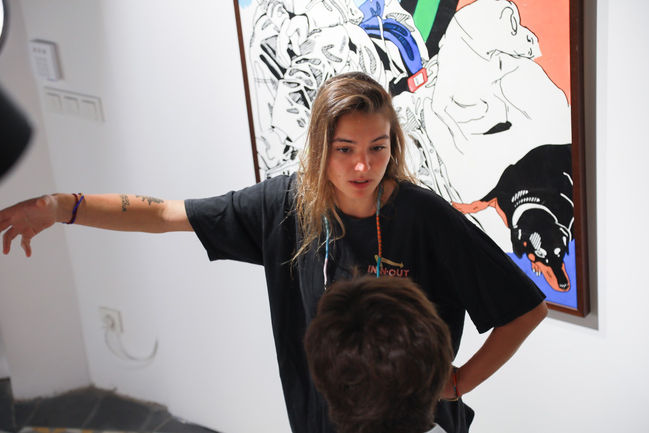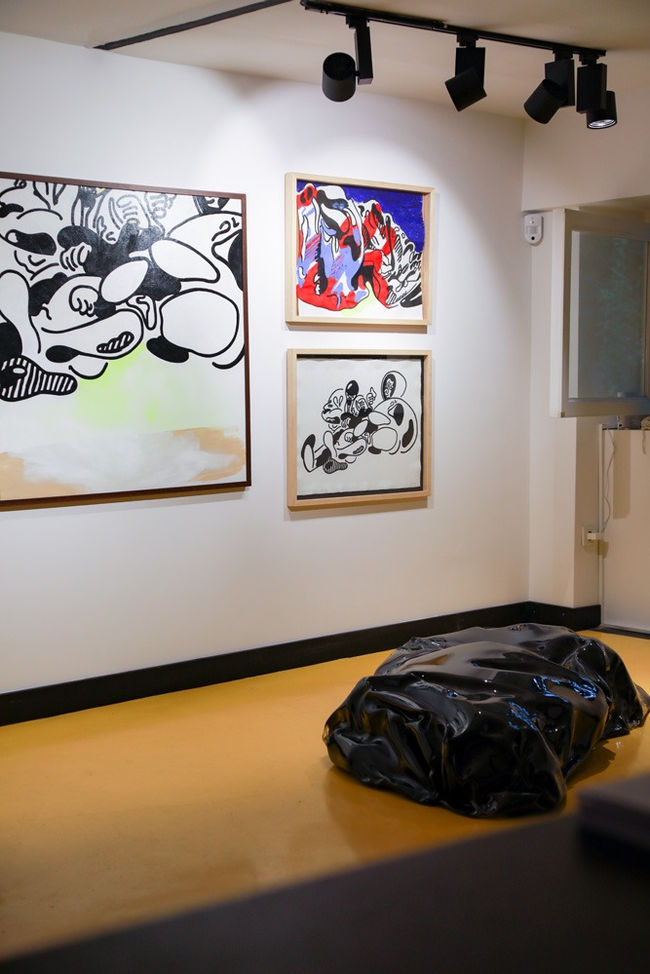
conceived in 2019 during artist residency “Le Laboratoire de La Creation” in Paris, France
“Stricken by the contradictive nature of everyday life on the streets of Paris – which the artist believes to be Europe’s most ambivalent city, with the project TOWNSMEN set as a unifying fabric throughout her time of artist-residency there, Elena Nazarova takes on two very contrasting routes of artistic exploration, research, and representation, which deepen as she leaps into the city’s darker corners and nightlife, and eventually lead her to explore possibilities for the perfect object to protest the status quo while pleasing the viewer simultaneously. These are pop culture and homelessness, in Paris, as two
opposite poles of society and modern life, both ever-present and perfectly tangible on the same streets and plazas, which the whole world has romanticized for centuries.
The issue of homelessness, which is one of the most pressing humanitarian crises globally, is inspected here through the lenses of the artist’s personal daily experience and interactions with the inhabitants of the several streets immediate to the studio she occupied for the period of the residency – precisely the area of “Chatelet Les Halles” much near Paris’s geographical center. The area is a cluster for tourists by day and a hot point for the homeless population by night, although the latter is little talked about. And this is essentially the ambivalence that provokes Elena to aim to shift definitions around, take what is there and is a striking reality and represent it on the spot, but in a way that is attractive so that people won’t look away.
For this TOWNSMEN takes on contemporary pop culture in art and lifestyle and begins to inspect the mechanisms at work behind the glamour and the attractive, searching to use it as a communication tool to highlight these contradictions in our social structure and ideologies. Meanwhile, under its surface, the work begins to tackle another discourse about public space as opposed to contemporary private domesticated life, as well as some disturbing aspects of today’s perplexed goals and ideals, consumer culture, and confused moral edifice.; That what used to be craved as luxurious has shifted into a fast culture of “HYPE”, and freedom as the highest virtue of recent past has been somehow replaced (once again) by labor, productivity, and personal achievements leaving out freedom in any romantic sense to the outcasts and derelicts of the modern world.
What could be then today, in our extensively structured and systematized society, a man of leisure, a detached observer, the “flaneur” as French poet Charles Baudelaire termed him? -Very likely only those who live entirely outside society’s systems (no address, no social security, etc.), but not hiding out in wilderness somewhere, but rather on the spot, sitting down, observing.
TOWNSMEN aims to expose the riotist nature of street people’s life and routine in a way exaggerated so as to give it certain jazz and make it seem momentarily glorious simply to draw attention to itself and a topic otherwise too easily avoided.
The exhibition presents the uncovered creative process of a project continuous in time”
























Images from 'TOWNSMEN project' exhibition, taken place in Plus359Gallery in Sofia, Bulgaria
26 November 2021 - 29 January 2022
“In the context of a foreign city dare to romanticize and appreciate the vast amount of collective energy accumulated from every separate individual." - That had been one of the first thoughts, that firmly came to my mind when I first arrived in Paris in late 2019 in response to Julien de Casabianca’s invitation to be a resident artist in “Le Laboratoire de la Creation” – a contemporary art studio, set at the very epicenter of the city, just above "Châtelet–Les Halles” – the largest underground station in the world, and a frequent home to many of Paris’s homeless.
As I was spending a lot of time in my little studio and working mostly by night, I was feeling quite disconnected from the city’s dynamics at first. And it was during that period of adjusting when the many people who spent their nights on the streets outside became the main focus of my work (being, as they are, by default disconnected to said same). Which meant I was choosing to look closely into something, which people seemed accustomed to avoiding, (un)consciously and physically. And every city creates and deals with similar issues of inequality, consumerism, violence, injustice, and greed, in Paris homelessness has been on the rise for decades and so, it is one of the first things you find yourself presented to when entering the city, both, in the context of a Metro warning, and as unavoidable scenery. So as tourists everywhere were doing their best to avoid the homeless in their selfies and Instagram picture frames, I kind of felt compelled to witness, and mirror, and reflect on the whole thing more truthfully. The truth being that the homelessness crisis in Paris, (with numbers of rough sleepers in the city’s metropolitan area having increased by roughly 84% in the preceding 10-15 years) is only a speck of the humanitarian catastrophe our western world is causing globally and daily. The ever-widening gap between rich and poor in this, otherwise well-functioning European megapolis, is so tangible here, that it almost takes effort not to think about the economic violence enacted upon the population and the state of exhaustion, the current EU civilization has reached.
While devoting time observing, taking pictures, and thinking about these people and the various aspects of their lives (from the very routine to the extraordinary bits), I kept noticing how different most particulars about their living are in comparison to the rest of the city’s inhabitants. Their communication channels, their mobility, the difficulties they face, but also the kind of freedom of not thinking about time much, invisibility strategies, etc. It was all so different and contrasting. And it was happening at the same time and public space as everything else, only somehow unnoticed. I dug into some research from the INSEE* and the biggest annual homelessness census project in the city “Nuit de la Solidarite”**. The numbers are saddening and they are increasing. More people in Paris end up in a precarious street living situation each year. The relative estimated number of rough sleepers is 30 000 for the wider metropolitan area. One survey done on aids needed was pointing out that 11% of homeless people interviewed in the counting said they do not need anything and confirmed that they choose this life and wouldn’t live in another “within the system” way. 11% here meaning about 400 people out of the 3641 counted in the census in 2019 within the borders of the city. How curious! The utopia of choosing freedom. I had begun thinking about the significance of public space and questioning on the ethical side the norms and policies in relation to it, implemented through urban spatial planning, and in our current circumstances, at the birth of what seems to be the age of civic disobedience and mass rebellion, such a choice of living could easily be considered a very solid statement and act of civic rebellion. I thought about how these people’s way of life, in its exceptional nature, is breaking somewhat the centuries-long chain of society’s domestication that everyone else is pretty much contributing to. After all, they are taking up their physical space and happening their life in what is the opposite of isolation, for everyone to see and be discomforted by.
I decided that I would like to depict these people in a glamorous way. I wanted to give them this definite “cool” sense as if they’re somewhat floating above all the botherings of the rest of the citizens. The mere thought of that was comic, but that was okay because, in artwork, I have always felt that highlighting a playful aspect of an otherwise tragic scene is discomforting enough to not be disrespectful and still manages to draw attention and provoke thought on the same problematic***. So practically my plan was to develop an own pop art & culture-inspired visual approach. Work from the images of real people I’ve encountered on the streets but stylize them to very clean and defined characters and create a series of appealing and attractive public artworks, from the kind that tourists tend to take selfies to, and in this way cause an opposite effect**** to address peoples ignorance.
Although they belong to the same disadvantaged group, I had no intention of generalizing or comparing one person to another. In reality, some of these people are amazing and full of light, while surely others have made some questionable decisions which led them to lead a life on the streets. Some are violent and some – peaceful, some are suffering and some are happy. With the language barrier in mind investing my days and creative energy in the exploration of this particular group of Parisians (and non-) has been a deeply transformative experience.
*“Institut national de la statistique et des études économiques” – France’s National Institute of Statistics and Economic Studies
**tr.: “Night of Solidarity”
***coming myself from an Eastern-European country, where approaching things from their comic side often seemed like the only good
way to approach social topics
****opposite to the reaction street people actually cause to tourists and other passers-by which would normally be indifference,
avoidance, and even repulsion
-Elena Nazarova; 2020